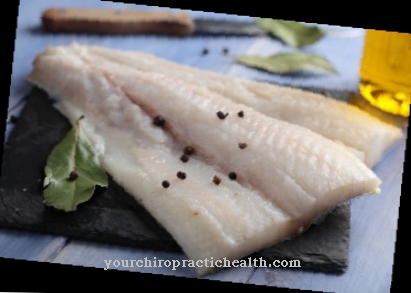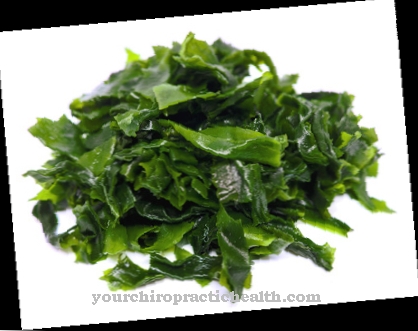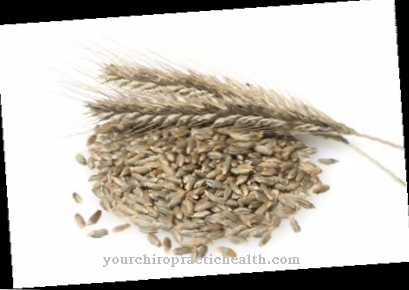The barley is a plant from the sweet grass family. Together with oats and wheat, it is one of the most important types of grain.
What you should know about barley

The barley is an annual plant that is between 0.7 and 1.2 meters high. Stem and leaves are hairless and smooth. The blade of grass stands upright. On it are alternate and two-line leaves.
The leaf blade is rather flat. It is between 10 and 25 centimeters long and up to 2 centimeters wide. There are two long auricles on the leaf sheath. These completely enclose the stalk of barley. The spikelets of barley are in a spike-like inflorescence. They stand in rows and are sessile. Each spikelet usually contains only one flower. The individual awns of the ear stand are between 8 and 15 centimeters long. When ripe, the fruit heads hang down with the awns.
The sweet grass originally comes from the Middle East and the eastern Balkans. Evidence for the use of barley can be found as early as 15,000 BC. The cultivated barley probably goes back to the wild barley (Hordeum vulgare). As a classic cultural grain, the plant was grown more than 8000 years ago in the area around the Nile. Together with einkorn and emmer, barley was one of the first types of grain that humans specifically cultivated. From the year 7000, high-yielding plants were used for further breeding.
Barley has also been grown in Central Europe since 5500 BC. In the Middle Ages, the sweet grass was used as fodder. Even today, winter barley is mainly used as animal feed. The variety, also known as feed barley, is more productive and contains more protein than spring barley. The spring barley is mainly used as brewing barley. It is processed into malt and brewing malt. Alternatively, spring barley can also be processed into groats or pearl barley. It is also occasionally ground into barley flour.
The barley grains are firmly fused with the barley husks. For human consumption they have to be freed from the husk. In the past, barley grains were peeled in one tanning process. Today this work is done by a special peeling mill.
Importance to health
The unpolished grains of barley provide many B vitamins and sufficient fiber. Fiber promotes healthy digestion and can help prevent gas and bloating.
The B vitamins perform various important tasks in the human body. They ensure a healthy nervous system, are involved in cell formation and strong hair and nails. In addition to vitamins, barley also provides essential minerals such as calcium and magnesium. Due to the complex carbohydrates it contains, barley is quick and long-lasting. The mucilage in barley forms a protective layer in the stomach and is therefore a boon for acidic mucous membranes. Barley can relieve or even prevent heartburn. Cooked barley has a calming effect similar to that of gruel or rice gruel.
Barley barley, on the other hand, is less rich in vitamins and nutrients than whole grains of barley. The shell is removed when the pearl barley is produced. It contains many minerals. However, there are also phytins in the shell. Phytins can bind minerals so that they can no longer be absorbed by the body. To remove the phytins, the barley grains should soak in cold water for one night before use. The phytins pass into the water and can then simply be thrown away.
Barley grass, which can be grown from the seeds of the barley, is of particular health importance. It impresses with its high density of vital substances. Not many foods have such a high content of minerals, trace elements, vitamins and bioflavonoids. It also contains plenty of chlorophyll. The green plant pigment also has numerous health benefits to offer for humans.
Ingredients & nutritional values
| Nutritional information | Amount per 100 gram |
| Calories 354 | Fat content 2.3 g |
| cholesterol 0 mg | sodium 12 mg |
| potassium 452 mg | carbohydrates 73 g |
| protein 12 g | Fiber 17 g |
The exact composition of barley varies depending on soil conditions, climate, variety and cultivation technique. Two thirds of the barley consists of carbohydrates. The fat content is rather low at 2.1 grams per 100 grams. 100 grams of barley contain just under 10 grams of protein.
The fiber content is 10 grams per 100 grams. With a mineral content of 2.3 grams, barley is rich in potassium, calcium, manganese, copper, iron, zinc, phosphorus, selenium and sodium. Vitamins such as vitamin A, vitamin B1, vitamin B3, pantothenic acid, folic acid and vitamin B6 are also included. Barley also contains several essential and semi-essential amino acids. These include arginine, isoleucine, leucine, lysine, threonine, tryptophan, valine, tyrosine, histidine, and methionine.
Intolerances & allergies
Food allergies to barley are rather rare. However, barley, like rye and wheat, contains gluten and should therefore be avoided by people with gluten intolerance. Since barley is also used in beer brewing, gluten-sensitive people do not tolerate beer so well.
Even with celiac disease, barley must not be consumed. Celiac disease is gluten intolerance. The intestinal mucous membrane is damaged by eating cereals containing gluten. Inflammation with diarrhea, weight loss, nutritional deficiencies, vomiting and abdominal cramps develop.
Shopping & kitchen tips
Barley grains are available in peeled form in supermarkets or health food stores. The peeled barley tastes mildly aromatic and can be used to make flour and flakes. A flake crusher or a grain mill is required for this.
The barley can also be ground. Packaged airtight and stored in the dark, the grains keep for around two years. The freshly ground barley flour or the fresh flakes should be used as soon as possible. They oxidize quickly and then taste rancid. Important nutrients are also lost on contact with the air.
Preparation tips
The ground barley can be used as flour for baking. Breads and other pasta work particularly well in combination with wheat flour. Barley flakes go well with various desserts or taste good in the morning muesli. The whole barley grains and the ground barley can be processed in a variety of ways. They taste good in soups and go well with many vegetable dishes.
Fresh barley grass can be grown from germinable barley grains. To do this, the seeds of the barley must be soaked in water overnight. The swollen seeds can then be spread in a planting bowl on moist soil the next morning. The seeds should be moistened regularly and not lie on top of each other. The small barley seedlings can be used in the salad after just three days. It takes ten to twelve days for the barley grass to be about 10 centimeters high. The grass can then simply be cut off with the scissors.
The cut blades of grass can be used in salads, soups, sauces or in cream cheese. A nutritious juice can also be made from the sweet grass. A special juicer is required for this. Alternatively, the fresh barley grass can also be used in smoothies. Dried barley grass is commercially available in powder form. With careful production, most of the nutrients are retained.
















.jpg)
.jpg)



.jpg)






